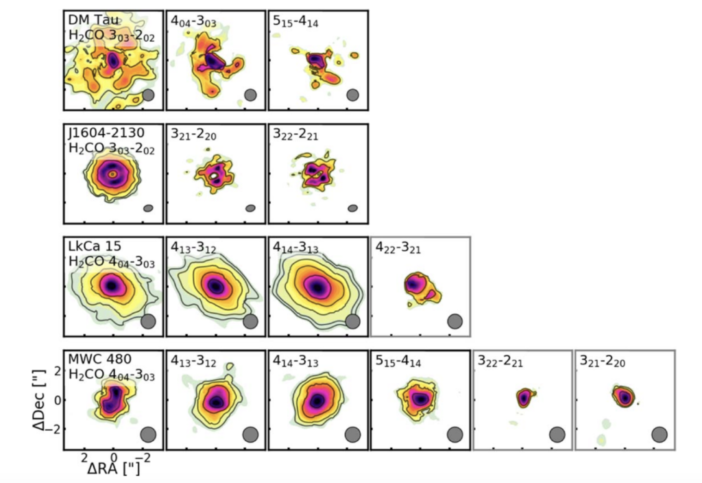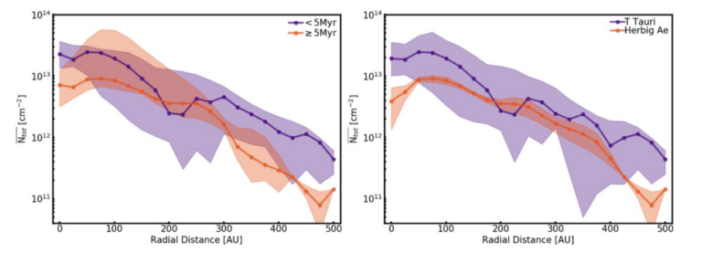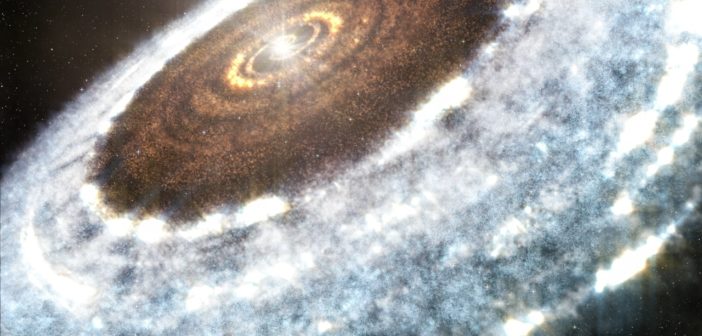Editor’s note: Astrobites is a graduate-student-run organization that digests astrophysical literature for undergraduate students. As part of the partnership between the AAS and astrobites, we occasionally repost astrobites content here at AAS Nova. We hope you enjoy this post from astrobites; the original can be viewed at astrobites.org.
Title: An ALMA Survey of H2CO in Protoplanetary Disks
Authors: Jamila Pegues, Karin Oberg, J. Bergner et al.
First Author’s Institution: Center for Astrophysics | Harvard & Smithsonian
Status: Published in ApJ
Person. Woman. Man. Camera. TV. What do all of these have in common? They are complex organisms or objects which are made of organic molecules. If we want to understand the origins of such earthly things, we need to understand how and where they form within protoplanetary disks. H2CO, or formaldehyde, is one of the most abundant organic molecules in the universe, and it can serve as a precursor to more complex organic molecules. Observing the location at which H2CO resides within a disk will provide insight into its formation, and thus the protoplanetary disk’s ability to form more complex molecules. Today’s paper surveys 15 protoplanetary disks looking at multiple H2CO lines. The authors seek to uncover the temperature, density, and origin of H2CO, which will inform our knowledge of chemistry within disks.
How Do You Form Molecules in Space?
There are two main formation pathways to form molecules within protoplanetary disks. You can form molecules in the gas via gas-phase chemistry, or you can form molecules on ice grains via ice–grain chemistry. Astronomers have seen that it is possible to create H2CO in both the gas phase and on grains, however we won’t know what the most common formation mechanism is within disks until we observe them. If H2CO is predominantly formed in the gas phase, we would expect to see a significant amount of H2CO near the center of a disk. This is because the inner few AU is where the gas is most dense, thus there is a higher likelihood of collisions between molecules that can form H2CO. If, on the other hand, ice–grain chemistry is the most common way to form H2CO, then we would expect to see a ring-like structure when observing the H2CO within a disk. This is because molecules “freeze out” onto grains at a certain temperature. To form H2CO on a dust grain, we need the molecule CO (carbon monoxide) to be chillin’ out on the dust grains. Chuck some hydrogen at it until it becomes H2CO, then it can be released off the grain for us to observe. So! We need CO to be not in the gas, but instead on the grains available for hydrogen to be thrown at them. That will only happen when the environment is so cold that CO begins to “freeze” onto dust grains, which only occurs pretty far away from the central star. That freeze-out location is called a snowline. Thus, if CO needs to be stuck onto ice grains to form H2CO, then we’d only see H2CO near the CO snowline, which will look like a ring around the star.

Figure 1: A cartoon representation of the location of H2CO if its primary formation mechanism was gas-phase chemistry (left) or ice-grain chemistry (right). [Astrobites]
¿Por qué no los dos?
After observing H2CO towards 15 disks, what did these authors find? They found that eight out of 15 observed disks had H2CO that peaked in the center, three had little “dips” (so there was not a super significant amount of H2CO), and two had no H2CO flux in the center. At the same time, they found that six out of 15 of their disks had ring-like structures, or plateaus of flux continuing from the center of the disk.

Figure 2: The emission maps of four different disks with multiple detections of transitions of H2CO. J1604-2130 (second from the top) is a great example of a disk that had missing H2CO flux in the center, plus ring-like structure, which suggests H2CO forms on ice grains in this disk. DM Tau (top) shows H2CO flux in the center of the disk, however it continues to extend quite far out, suggesting both gas-phase chemistry and ice–grain chemistry is taking place. [Pegues et al. 2020]
A Gift That Keeps On Giving
Not only do these observations of H2CO tell us about the formation pathways of this organic molecule, but they also provide measurements of temperature and density within the disks. For disks with multiple line observations corresponding to different energetic transitions of H2CO, the authors can do some physics magic to pull out the excitation temperature and column densities of H2CO. With that information, they can then compare the densities of H2CO between different types of disks. They see a difference between the biggest and warmest disks (Herbig Ae disks) and the cooler smaller disks (T Tauri disks). The Herbig Ae disks tend to have less H2CO than the lower mass/cooler counterparts. This is consistent with other lower resolution observations of H2CO. This relation is still tentative, as only a handful of disks are sampled, but the authors propose that this correlation is due to Herbig Ae disks being too warm for ice–grain chemistry.

Figure 3: Comparing the average column densities of H2CO in old vs. young disks (left) and Herbig vs T Tauri disks (right). There isn’t a significant change in H2CO column densities when looking at disks of different ages, however there is a somewhat significant difference between Herbig disks (orange) and T Tauri disks (purple). [Pegues et al. 2020]
About the author, Jenny Calahan:
Hi! I am a second year graduate student at the University of Michigan. I study protoplanetary disk environments and astrochemistry, which set the stage for planet formation. Outside of astronomy, I love to sing (I’m a soprano I), I enjoy crafting, and I love to travel and explore new places. Check out my website: https://sites.google.com/umich.edu/jcalahan

2 Comments
Pingback: How do Imines Form in Space Clouds? | astrobites
Pingback: How Do Imines Form in Space Clouds?